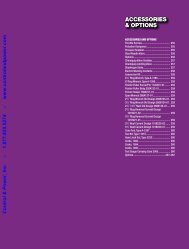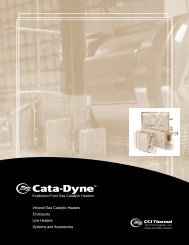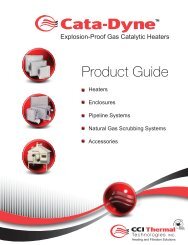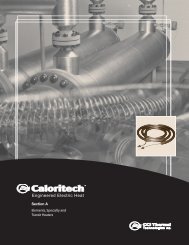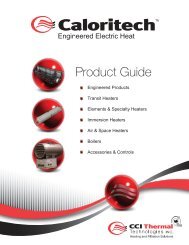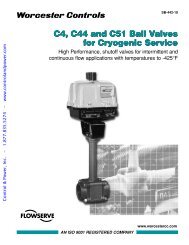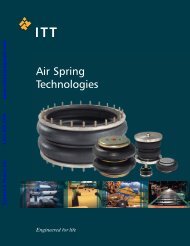Gestra Products Technical - Control And Power
Gestra Products Technical - Control And Power
Gestra Products Technical - Control And Power
You also want an ePaper? Increase the reach of your titles
YUMPU automatically turns print PDFs into web optimized ePapers that Google loves.
For steam and energy management,<br />
we are right on target<br />
Steam Trap Selection<br />
Not all steam trap types are equally suitable for a given application.<br />
Depending on the operating conditions and service in question, one or<br />
more systems will be particularly well suited.<br />
Ratings:<br />
1 = Excellent<br />
2 = Good<br />
3 = Fair or conditional<br />
– = Not recommended, unsuitable<br />
Trap type BK with<br />
bimetallic regulator<br />
<strong>Technical</strong> information on steam trapping and trap selection<br />
The following table contains 15 criteria for steam trap<br />
selection based on the operation of the plant and the specific<br />
requirements on the part of the plant owner.<br />
Trap type MK with<br />
membrane regulator<br />
Steam trap types<br />
Criteria Please note:<br />
Ball float trap type UNA<br />
with Duplex control<br />
1. Operation with Condensate from steam 1 1 1 1<br />
different Condensate from compressed air – – – 1<br />
condensates Condensate, distillate from<br />
– – – 1<br />
chemical products<br />
2. Different modes Continuous operation:<br />
of operation Constant formation of condensate; 2 1 1 1<br />
flowrate and pressure vary<br />
Discontinuous operation:<br />
Ball float trap type UNA<br />
with Simplex control<br />
For “cold” condensates or condensates with a saturation<br />
curve deviating from that of water only float traps featuring<br />
Simplex control<br />
(without thermal venting) can be used.<br />
Intermittent formation of condensate;<br />
flowrate and pressure vary strongly<br />
2 1 1 3*) *) e. g. air venting difficulties<br />
Any operation: Heat exchanger may<br />
be controlled on the steam side 3**) 2 1 3*)<br />
*) Air venting difficulties, **) With partial load (reduced<br />
differential pressure) flowrate possibly not sufficient<br />
3. Operation with Up to approx. 30 % of upstream pressure 1 1 1 1<br />
back pressure From 30 % to 60 % of upstream pressure 3*) 1 1 1 *) Possibly readjustment required<br />
> 60 % of upstream pressure 3*) 1 1 1 *) Possibly readjustment required<br />
4. Sensitivity to dirt Highly contaminated condensate 1 1 1 1<br />
5. Air-venting Automatic 1 1 1 3*) *) Manual air-venting<br />
6. Condensate Condensate temperature nearly<br />
discharge at boiling temperature<br />
definite<br />
temperatures<br />
2*) 2**) 1 1<br />
This may apply to small heat exchangers<br />
(e. g. laboratory equipment)<br />
*) Possibly readjustment required<br />
**) Might require special membrane regulator<br />
Condensate undercooling<br />
approx. 30 K (required)<br />
1*) 1**) – –<br />
*) with U-type regulator or by readjustment<br />
**) with U-type capsule<br />
Condensate undercooling *) By a corresponding readjustment reduction<br />
adjustable 2*) – – – in flowrate; if possible use steam trap with<br />
adjustable discharge temperature UBK<br />
7. Frost resistance 1 1 1*) 3*) *) Only ensured with V-type design<br />
8. Condensate Intermittent condensate formation 1 1 1 1<br />
discharge without Reduced condensate formation (< 10 kg/h) 1 1 1 1<br />
loss of live steam Continuous condensate formation (> 10 kg/h) 1 1 1 1<br />
9. Resistance to waterhammer 1 1*) 3*) 3*) *) Built-in non-return valve = 1<br />
10. Non-return valve action 1 1*) –*) –*) *) Built-in non-return valve = 1<br />
11. Application in vacuum 3 2 1 1<br />
12. Installation in any position 1 1 –*) –*) *) UNA 1... can be converted<br />
13. Ease of maintenance 1 1 1 1<br />
14. Service life of control unit 1 2 1 1<br />
15. Application with superheated steam 1 3 3*) 1 *) UNA 1.. like MK, UNA 2.. not recommended<br />
Title of publication GESTRA Information # / Medium<br />
Steam trap selection program CD-ROM<br />
Condensate manual: Basic principles of steam trapping, sizing of steam and condensate return lines,<br />
selection and application of steam traps etc.<br />
Paperback<br />
Physical basis for evaluating steam-trap performance A 1.1<br />
Automatic drainage of steam and condensate systems during start-up and shut-down A 1.2<br />
Waterhammer and how to avoid it A 1.3<br />
How to avoid operating trouble A 1.5<br />
Ball-float traps for draining compressed-air plants A 1.6<br />
Automatic deaeration of steam-heated heat exchangers A 1.7<br />
Drainage of rotary cylinders A 1.8<br />
Utilization of sensible heat of condensate C 1.2<br />
A1



